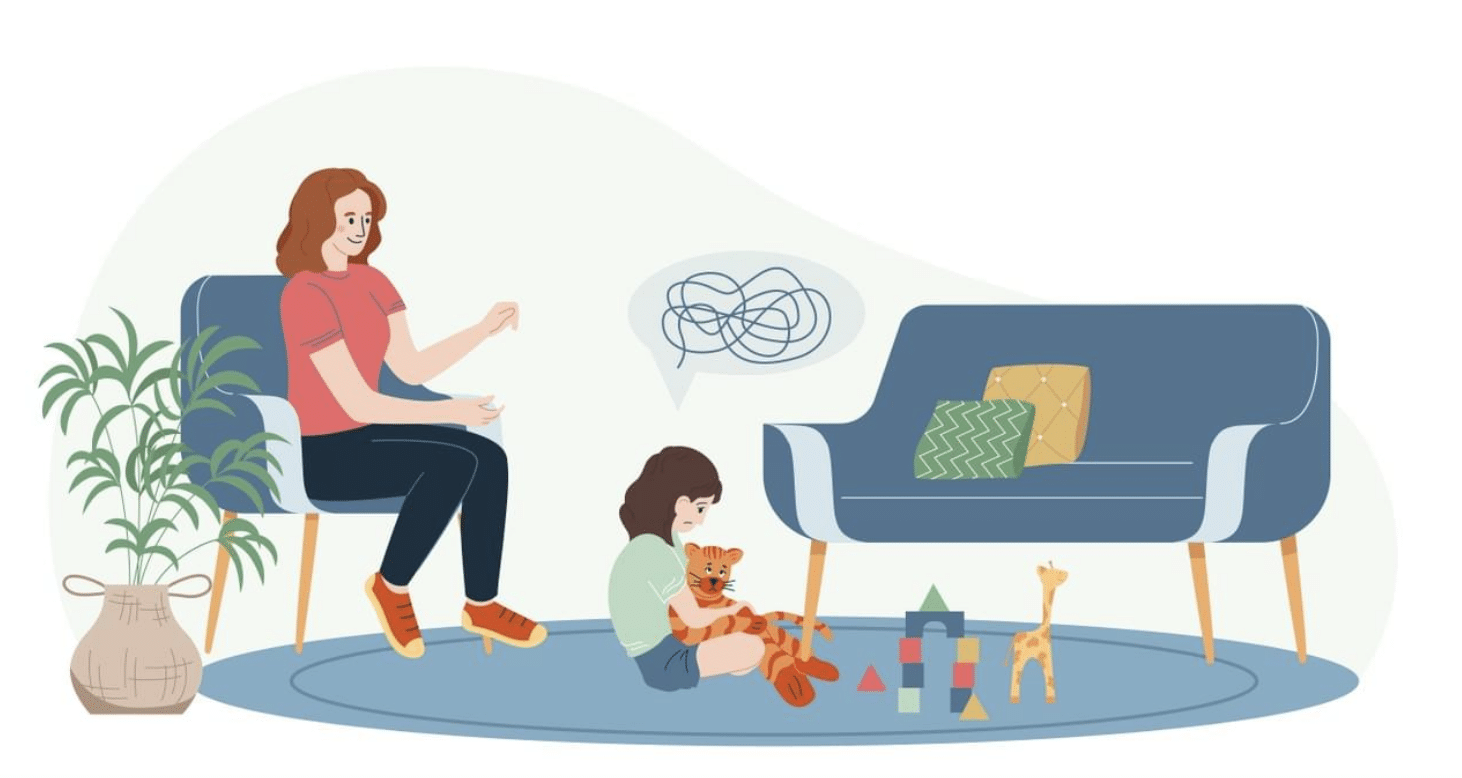According to a report from the American Speech-Language-Hearing Association (ASHA), a significant number of children who are grappling with speech development issues are at risk of missing the narrow timeline for improvement. According to the NIH, the initial three years of life constitute the most critical period for the development and maturation of the brain, representing an intensive phase for acquiring speech and language skills. Furthermore, Optimal development occurs within an environment that is abundant in diverse sounds, visual stimuli, and consistent exposure to the speech and language patterns of others. During this crucial stage, the young brain is particularly receptive and responsive to the richness of stimuli, laying the foundation for the acquisition of essential communication skills.
A study from J Family Med Prim Care strongly suggests that untreated speech and language delay can persist in a significant percentage of children, ranging from 40% to 60%, exposing them to a higher risk of social, emotional, behavioral, and cognitive challenges in adulthood. Estimating the prevalence of speech delay has been challenging, largely due to the traditional belief that it may have a family connection and is not necessarily a cause for immediate concern. This often results in a “wait-and-watch” approach, contributing to delayed diagnosis and intervention for speech delay. Recognizing the crucial role of primary care clinicians and family physicians as the initial point of contact for children with speech and language delay, it becomes their responsibility to identify apparent signs of delay and address parental concerns promptly.
This is particularly concerning, since according to a study by the CDC, the percentage of children aged 3-17 years who are diagnosed with a developmental disability increased from 16.2% to 17.8% from 2015 to 2017. This increase in children struggling with expressive language disorder, a condition that affects their ability to effectively communicate and express themselves, underscores the pressing need for early intervention and support in speech and language development. These children face unique challenges in expressing their thoughts, emotions, and ideas, making it crucial to identify and address expressive language disorder as early as possible to ensure that they receive the necessary assistance and therapies for their linguistic and emotional growth. The findings from ASHA’s report emphasize the urgency of raising awareness and allocating resources to help these children overcome their expressive language disorder and reach their full potential.
Matthew Kwok, co-founder of PenguinSmart said this pressing demand underscores the significance of inclusive speech development. Nevertheless, the scarcity of speech and language pathologists poses a challenge, hindering timely and comprehensive interventions.
In This Article
Barriers to Speech Development
Barriers to early intervention (EI) pose significant challenges in ensuring equitable access to crucial developmental support for children. One of the primary obstacles is the intersectionality of race, ethnicity, and socioeconomic status. These factors, while individually influential, often compound each other, creating formidable barriers. The impact of race and ethnicity on early intervention access is substantial, as shared experiences and cultural nuances can affect the frequency of referrals, access to services, and overall utilization of early intervention.
Ethnicity, defined by one’s connection to a particular culture, further complicates the landscape, contributing to disparities in disability diagnosis, intervention access, and parental confidence in the provided interventions. When coupled with socioeconomic status, these disparities intensify, particularly for low-income families. Socioeconomic factors, such as income and educational level, significantly influence the timing of diagnoses and access to services. Children from low-income backgrounds are not only diagnosed later in life but are also less likely to receive the essential support early intervention offers.
Moreover, the educational level of parents plays a pivotal role, as lack of awareness about developmental milestones and the benefits of early intervention can impede timely access to services. In addressing barriers to early intervention, it is imperative to recognize and understand the intricate interplay of these factors to develop targeted strategies that ensure all children, regardless of their background, can access the support necessary for optimal development.
The scarcity of speech and language pathologists poses several challenges for individuals in need of speech therapy, particularly those grappling with expressive language disorder and expressive language delay, and for the healthcare and education systems as a whole:
- Limited Access to Services: In areas with a shortage of speech and language pathologists, individuals, particularly in rural or underserved areas, may have limited access to essential speech therapy services for addressing expressive language disorder and expressive language delay. This lack of access can result in delayed or inadequate treatment, potentially affecting their long-term communication skills and quality of life.
- Waiting Lists: Due to the scarcity of speech pathologists, many clinics and schools may have long waiting lists for evaluation and therapy services aimed at addressing expressive language disorder and expressive language delay. This can lead to delays in diagnosing and addressing speech and language issues, which are often most effective when addressed early in a person’s development.
- Overworked Professionals: In regions with a shortage of speech and language pathologists, the existing professionals may become overworked, with heavy caseloads and limited time to provide comprehensive care for individuals struggling with expressive language disorder and expressive language delay. This can impact the quality and effectiveness of therapy and may lead to therapist burnout.
- Reduced Specialized Services: In areas with a scarcity of speech therapists, individuals with complex speech and language disorders, including those related to expressive language disorder and expressive language delay, may struggle to find professionals with the expertise required to address their specific needs. Specialized services for these conditions may be especially lacking.
- Increased Costs: When demand for speech therapy services for expressive language disorder and expressive language delay outstrips the supply of pathologists, the cost of therapy can rise, making it financially challenging for some individuals and families to access necessary care.
- Impact on Education: Schools often rely on speech and language pathologists to provide support to students with speech and language disorders, including expressive language disorder and expressive language delay. The scarcity of professionals in this field can affect the quality of special education services and impact students’ academic progress.
- Difficulty in Early Intervention: Early intervention is crucial for children with speech and language disorders like expressive language disorder and expressive language delay. The scarcity of pathologists can result in delayed identification and treatment, potentially affecting a child’s development and educational outcomes.
Addressing the scarcity of speech and language pathologists, particularly those specializing in expressive language disorder and expressive language delay, often requires efforts to increase the number of professionals entering the field, as well as strategies to ensure a more equitable distribution of services. This can involve increasing funding for training programs, offering incentives to attract professionals to underserved areas, and promoting awareness of the importance of speech therapy services in healthcare and education systems.
Expressive Language Challenges in Children: From Speech Delays to Early Intervention
Expressive language disorder and expressive language delay are common forms of developmental challenges, affecting approximately one in five children. In some cases, these children may also experience behavioral difficulties stemming from their frustration in effectively communicating their needs or desires. While simple speech delays, such as expressive language delay, can often be temporary and may resolve naturally or with additional support from the family, it’s essential for parents and caregivers to play an active role. Encouraging your child to communicate through gestures or sounds and dedicating ample time to playing, reading, and conversing with them is crucial during their infant and toddler years, especially when dealing with expressive language disorder or expressive language delay.
Effective communication is a cornerstone of human interaction, and when individuals face hurdles expressing themselves, it can lead to behavioral difficulties, especially in the context of speech delay. The frustration arising from the struggle to articulate thoughts and feelings can contribute to what is commonly termed ‘challenging behavior’, which may manifest in various ways such as verbal abuse, shouting, physical aggression, or socially unacceptable actions. Challenging behavior can spring from a variety of triggers, including confusion, disorientation, fear, anxiety, and frustration due to impairments in cognition and communication, including language processing.
Challenging behavior, in all its forms, serves a communicative purpose, signaling that there is something the individual wants or a problem/need that requires attention. Owing to the effects of speech delay, individuals may find themselves struggling to express their wants and needs in a more appropriate and effective manner, leading to breakdowns in communication. This breakdown can give rise to a spectrum of emotions and needs, including fear, anxiety, confusion, distress, anger, and frustration.
Individuals may resort to challenging behavior as a way to communicate their lack of understanding of a situation, the inability to identify the cause of their distress due to cognitive problems, or the struggle to express needs clearly due to communicative or cognitive impairments. The behavioral manifestations may also indicate feeling overwhelmed, coping difficulties with physical and cognitive demands, or challenges in adapting to living/social circumstances.
Understanding the communicative purposes behind challenging behavior is crucial. It can reveal a wide array of emotions and needs, from basic physical requirements like hunger and thirst to more complex feelings such as loneliness, boredom, or a desire for connection. By delving into the intricacies of an individual’s experiences and challenges, caregivers and support systems can gain insights that facilitate better communication.
In essence, speech delay can act as a catalyst for behavioral challenges, underscoring the importance of tailored interventions and support. Recognizing the underlying frustrations and emotions that drive challenging behavior allows for a more empathetic and informed approach. Getting to know individuals on a personal level becomes paramount, paving the way for a deeper understanding of their unique communication needs and decreasing the occurrence of challenging behavior. Through this approach, we can decode the language barrier and provide a more compassionate and effective support system for those navigating the complexities of speech delay.
In complex cases, involving a trained speech and language therapist is vital. Language delays can also signal deeper concerns like hearing loss, developmental delays, or autism spectrum disorder (ASD).
Addressing Speech Challenges in Children
An inclusive approach to speech therapy encompasses a multifaceted strategy that embraces diverse aspects of care, ensuring that every child’s unique needs and challenges are addressed. It begins with meticulous progress tracking, where therapists and caregivers collaborate closely, using data-driven insights to fine-tune therapy strategies. This collaborative effort guarantees that milestones are not only achieved but also celebrated, fostering a sense of achievement and motivation for both the child and their support network.
PenguinSmart’s method goes beyond simple speech delays, extending to various communication challenges, such as conditions like verbal dyspraxia and autism. Acknowledging that each child’s journey is unique, PenguinSmart tailors interventions to meet their specific requirements, allowing for a highly personalized approach. By leveraging cutting-edge technologies and the expertise of professionals, these personalized interventions, which are at the heart of how PenguinSmart can help, are optimized to achieve better outcomes for children struggling with speech development. Click here to learn more.
Breaking Barriers and Expanding Access
Furthermore, this inclusive ethos goes the extra mile to transcend the limitations of physical boundaries, harnessing the full potential of innovative telehealth platforms to ensure that speech therapy is not bound by geographical constraints. This forward-thinking approach serves as a lifeline for families living in remote or underserved areas, granting them access to the same high-quality care that their counterparts in urban centers receive when dealing with expressive language disorder and expressive language delay.
Additionally, the inclusive approach doesn’t stop at geographical inclusivity. It extends to the financial dimension, recognizing that economic obstacles can be a significant impediment for many families seeking speech therapy services. Speech therapy can be expensive. According to the article “How Much Does Speech Therapy Cost?” by Connected Speech Pathology, the cost of speech therapy sessions can vary depending on several factors. A speech-language evaluation typically ranges from $150 to $400, while a half-hour therapy session may cost between $65 and $175.
To address this concern, the inclusive approach introduces flexible payment options, allowing families from various economic backgrounds to access the necessary care without being burdened by prohibitive costs. Moreover, this approach explores insurance coverage possibilities, ensuring that quality speech therapy is not only accessible but also financially feasible for every child who requires support in managing expressive language disorder or expressive language delay.
In conclusion, the journey to overcome speech development challenges demands a comprehensive and inclusive approach, and telehealth platforms like PenguinSmart are at the forefront of breaking barriers and expanding access to crucial care. The evidence underscores the urgency of addressing speech and language delay during the critical early years, as untreated issues can persist into adulthood, leading to a myriad of social, emotional, behavioral, and cognitive challenges. The inclusive care and telehealth revolutionize the landscape of pediatric speech therapy, ensuring that no child is left behind in their journey to overcome expressive language challenges. The collaborative efforts of therapists, caregivers, and innovative platforms like PenguinSmart pave the way for a future where every child can thrive and reach their full potential in communication and emotional well-being.











